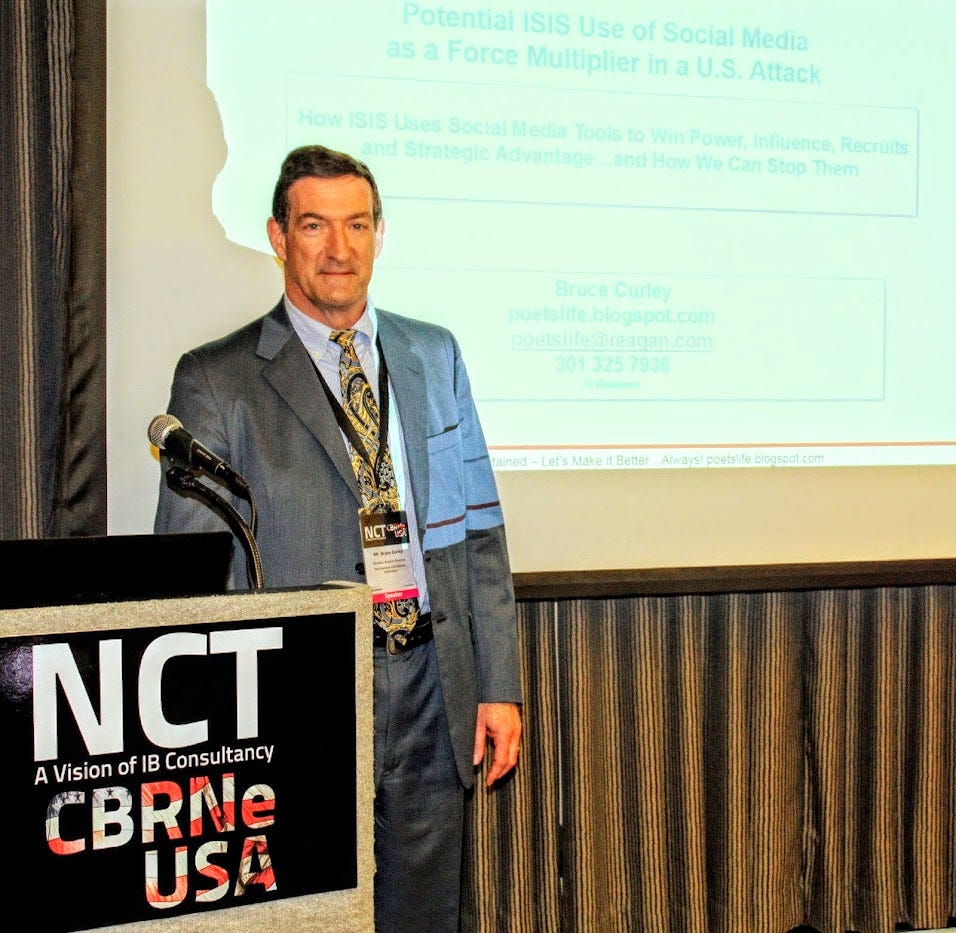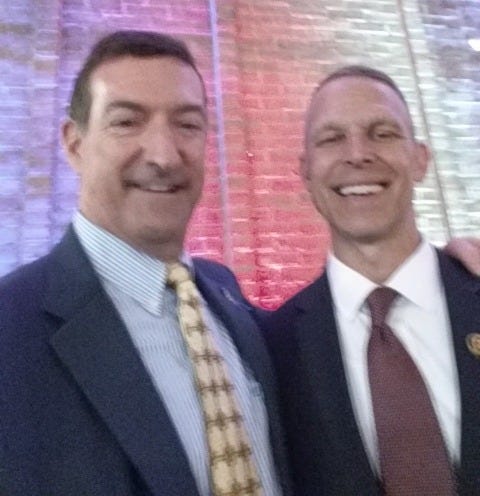My Civil Defense Radio Interview
American elites prepare for disasters, so should you and your family. Back in 2020, I spoke to Preston Schlienkofer who interviewed me on Civil Defense Radio about Children and Civil Defense. I highly recommend that you follow him.
The topic we discussed that day was Children and Civil Defense. We also talked about The American Civil Defense Association (TACDA). Here are a few links he listed in 2020 that are even more relevant today.
TACDA Website: https://tacda.org
TACDA Survival Store: https://tacda.org/the-survival-store/
TACDA Journal of Civil Defense: https://tacda.org/journal-topic/journal-of-civil-defense/
TACDA Academy: https://tacda.org/resources/#TACDA-ACADEMY
Children and Civil Defense: https://poetslife.blogspot.com/2018/10/why-civil-defense-matters-for-children.html
Church Emergency Evacuation, Shelter-in-Place, and Lock-Down Plan https://poetslife.blogspot.com/2017/05/church-emergency-evacuation-shelter-in.html
Civil Defense Radio Information
Website: http://civildefenseradio.com/
Facebook: https://www.facebook.com/CivilDefenseRadio
Twitter: https://twitter.com/Civil_Def_Radio
My American Survival Raven Rock Interview
When “doomsday” comes, America's elites will hide in places like Raven Rock, one of many secret military compounds and nuclear hideaways outside of Washington, D.C., throughout the U.S., and other elite hideaways and bunkers in New Zealand. Cliff Kincaid discusses what ordinary people can do to protect themselves with Bruce Curley of The American Civil Defense Association.
Here is the link to the interview: Countdown to Doomsday.
Secret Military Compounds and Nuclear Hideaways
Although rarely covered in the media, here are greater details on U.S. secret military compounds and nuclear hideaways, thanks to Grok.
The United States has maintained several secret military compounds and nuclear hideaways, primarily designed for continuity of government (COG) and defense operations during a nuclear attack or catastrophic event. These facilities were constructed during the Cold War to protect key government officials, military personnel, and critical operations.
Below is a detailed list of known or declassified secret military compounds and nuclear hideaways outside of Washington, D.C., based on available information. Note that some details remain classified, and access to these sites is highly restricted.
1. Raven Rock Mountain Complex (Site R) (Blue Ridge Summit, Pennsylvania)
Location: Near Blue Ridge Summit, Pennsylvania, close to the Maryland border, approximately 60 miles from Washington, D.C.
Purpose: Acts as an alternate command center for the Pentagon and a relocation point for National Command Authorities. It is often called the "underground Pentagon."
Description:
Carved into Raven Rock Mountain, it contains 600,000 to 700,000 square feet of underground space with multiple chambers up to 50 feet wide and 100 feet high.
Houses an extensive telecommunications center for the U.S. Air Force, Army, and Navy, managed by the Defense Threat Reduction Agency.
Capable of supporting about 5,000 personnel in an emergency, though it typically operates with around 100 staff.
Vice President Dick Cheney used it as a secret hideaway post-9/11, and it was reactivated and expanded after the attacks.
Secrecy: While its existence is documented, specific operations remain classified. It was accidentally referenced in a 2008 Pentagon conference packet, highlighting its secrecy.
Current Status: Fully operational and a critical COG facility.
1. Mount Weather Emergency Operations Center (Bluemont, Virginia)
Location: Approximately 46 miles west of Washington, D.C., in the Blue Ridge Mountains, near Bluemont, Virginia.
Purpose: Serves as a primary hub for the Federal Emergency Management Agency (FEMA) and is a key continuity of government facility. It is designed to house civilian and military officials during a nuclear attack or national emergency.
Description:
Built into a granite mountain, it is a "small city" with vast office spaces, sleeping accommodations for thousands, a private reservoir, and a crematorium.
Features a replica mini-government with its own police, fire department, and laws. It reportedly includes files on Americans and a studio for post-nuclear presidential broadcasts.
Congressional leaders, including House Speaker Dennis Hastert, were evacuated here after the 9/11 attacks.
Managed by FEMA and the Department of Homeland Security, it is surrounded by tall, razor-wire fencing with strict "No Trespassing" warnings.
Secrecy: Its existence was partially revealed after TWA Flight 514 crashed nearby in 1974, and it was further exposed by media reports. It remains operational and highly classified.
Current Status: Fully operational, with ongoing use for emergency preparedness and COG functions.
2. Project Greek Island (Greenbrier Resort, White Sulphur Springs, West Virginia)
Location: Beneath the Greenbrier Resort in White Sulphur Springs, West Virginia, about a four-hour drive (250 miles) from Washington, D.C.
Purpose: Designed to serve as a relocation site for the U.S. Congress in the event of a nuclear attack.
Description:
Constructed between 1958 and 1962 under President Eisenhower’s orders, codenamed "Project Greek Island."
A 112,000-square-foot underground bunker protected by 5-foot-thick concrete walls and 18- to 25-ton blast doors.
Equipped with over 1,000 bunk beds, a 400-seat cafeteria, auditoriums for the Senate and House, vast water tanks, and a trash incinerator that could function as a crematorium.
The air-intake system was designed to filter out radioactive fallout, and it was stocked with 30 years of supplies.
Maintained in secret by a cover company, Forsyth Associates, posing as TV technicians.
Secrecy: Kept hidden from 1958 until exposed by a Washington Post article in 1992. Local residents suspected a government installation but were unaware it was for Congress.
Current Status: Decommissioned as a bunker, it is now a tourist attraction and historic site at the Greenbrier Resort.
3. Cheyenne Mountain Complex (Colorado Springs, Colorado)
Location: Near Colorado Springs, Colorado, within Cheyenne Mountain.
Purpose: Originally built for the North American Aerospace Defense Command (NORAD) to monitor and respond to nuclear threats. It serves as a nuclear-hardened command and control center.
Description:
An expansive underground fortress with advanced oxygen systems, its own power plant, and water supply, designed to withstand nuclear attacks.
Ensures 99.999% reliability for utilities, making it one of the most secure bunkers in the U.S.
Unlike other COG facilities, its existence was never secret, though specific operations are classified.
Used for missile warning and space surveillance, with backup command functions for NORAD.
Secrecy: Publicly acknowledged, but internal details and current operations remain classified.
Current Status: Operational, though some NORAD functions have moved to Peterson Air Force Base. It remains a backup command center and was referenced in a 2025 X post as a repurposed facility.
4. Mount Pony (Culpeper, Virginia)
Location: Near Culpeper, VA, approximately 70 miles from Washington, D.C.
Purpose: Served as a continuity of government facility and the principal hub for the U.S. Federal Reserve’s secure communications system until 1992.
Description:
A 44,000-square-foot underground bunker designed to protect government officials during a nuclear war.
Housed the Culpeper Switch, managing trillions of dollars in Federal Reserve transactions.
Staffed by 100 personnel to maintain readiness for relocating officials.
Secrecy: Classified until the 1990s, when it was decommissioned as a COG site.
Current Status: Transferred to the Library of Congress in 1997 for use as the National Audio-Visual Conservation Center.
5. Warrenton Training Center (WTC) (Warrenton, Virginia)
Location: Warrenton, Virginia, about 43 miles from Washington, D.C., with multiple stations (Station A and Station B).
Purpose: Supports the National Communications System, ensuring federal government communications during a nuclear attack or emergency.
Description:
Station B includes multi-story underground buildings constructed in the late 1980s, designed for secure communications.
Station A serves as an administrative, training, and residential compound.
Links all major federal emergency bunkers and supports departments like Defense, Agriculture, Energy, and the NSA.
Secrecy: Officially administered by the Army, but little is publicly released about its functions. The Federation of American Scientists notes its extensive underground infrastructure.
Current Status: Operational, with ongoing use for secure communications.
6. Camp Century (Greenland, U.S. Territory)
Location: Deep within a glacier in Greenland, under U.S. military control.
Purpose: Ostensibly a scientific research station, it was a cover for Project Iceworm, a Cold War plan to create a nuclear missile base within the ice.
Description:
Built in 1960 as a nuclear-powered city carved into the glacier, with tunnels for up to 200 personnel.
Intended to house 600 nuclear-tipped missiles aimed at the Soviet Union, with railway tracks for covert transport.
Powered by an experimental nuclear reactor, which posed radiation risks to workers.
Secrecy: Classified until declassified documents revealed Project Iceworm decades later. Even Greenland’s Danish government was unaware of the missile plan.
Current Status: Abandoned in the 1960s, with tunnels collapsed under glacial movement. Its legacy includes scientific ice core samples preserved from the site.
Other Notable Sites
Ozarks Hardened Facilities (Missouri/Arkansas)
Referenced in a 2025 X post as three hardened underground facilities in the Ozarks, though specific details are unverified and classified. These may be part of COG or military communications networks.
No public records confirm their exact locations or purposes, suggesting they remain highly secretive.
Classified Submarine Bases (South Pacific)
Mentioned in a 2025 X post as classified bases, likely for nuclear submarine operations. These could include facilities like Naval Base Guam, part of Joint Region Marianas, but specific South Pacific sites remain undisclosed.
Bohemian Grove (Monte Rio, California)
A 2,700-acre private retreat for the Bohemian Club, not a military facility but historically significant for a 1942 Manhattan Project planning meeting that contributed to the atomic bomb.
While not a nuclear hideaway, its secrecy and elite gatherings (including presidents and military leaders) make it a related point of interest.
Trinity Site (White Sands Missile Range, New Mexico)
Location of the first atomic bomb test in 1945, codenamed Trinity. While not a hideaway, it was a top-secret military compound during its operation.
Now part of White Sands Missile Range, it is closed to the public except for biannual open houses.
Notes on Secrecy and Current Relevance
Secrecy: Many of these facilities were built during the Cold War under strict secrecy, often disguised as other projects (e.g., Greenbrier’s “conference center”). Even today, operational details are classified, and some sites may remain undisclosed.
Cold War Context: The U.S. constructed nearly 100 COG facilities within a 300-mile radius of Washington, D.C., known as the Federal Arc, to ensure government survival post-nuclear attack.
Post-9/11 Revival: Facilities like Raven Rock and Mount Weather were reactivated and expanded after 9/11, reflecting their ongoing importance in national security.
Limitations: Bunkers were designed for short-term survival (e.g., 30 days), not long-term habitation, and could not mitigate the catastrophic aftermath of nuclear war.
Unverified Claims: X posts mention facilities like the Ozarks and South Pacific bases, but without corroborating evidence, these remain speculative. Always treat such claims as inconclusive.
My American CCP Cyber Threat Theft Interview
Bruce Curley is the volunteer vice president of the American Civil Defense Association. Here he discusses Communist China's cyber attack strategy, including the theft of medical records from Frederick Health, a medical group serving top U.S. political, intelligence, and military officials in the DC-Maryland area. Here is the interview link: CCP Cyber Threat Theft of DC Elite Medial Records.
Cliff Kincaid posted my Cybersecurity is Everyone’s Business article on America’s Survival on USA Survival.
For personal safety and security information, go to www.TACDA.org and subscribe to the American Tactical Civil Defense Substack newsletter.
Bonus
TACDA Journal of Civil Defense with the theme America’s Next War: Cyberspace. My contribution is Cybersecurity is Everyone’s Business: Protect Your Family. The link follows.
Celebrating the Plumbing
This new sink plumbing
is a lesson in humility and place.
The old gray polybutylene pipes
that were so defective
they are no longer sold
had to be replaced
with pipes and fixtures
so space age
as to make me believe
it will be new plumbing,
rather than new computers,
that allow us to find,
conquer and settle new planets
in a generation hence.
The old faucet
that used to get in the way
was replaced by one
with a swan neck that allows
the placement of dishes
in every angle in the sink.
The two pearl handles
add to its visual and sensual appeal.
The rotted old wood
from the old leaky plumbing
had to be ripped out and replaced
with new wood of younger and firmer make.
Then that wood was covered with caulk and glue
And tile so form fitting and tight
that the new plumbing, should it ever leak,
will not end up in pools of wasted water
in the basement, as before.
All of this was done on the promise of
physical love rewards from my wife,
rewards which she never delivered
after the new sink was done.
In marriage, patience is a virtue
And the secret to a long life.
That's all right.
I'm not the first man to advance the cause
of civilization, or plumbing,
on the promise of flesh love
from my ever-confusing beloved.
Nor will I be the last to have to deal
with newly clogged pipes.
In the end,
the plumbing and faucet work beautifully,
even if they sit there unused
most of the time, it is great
to still have them ready to flow.
On such simple and incremental steps
Does civilization continue…
For the children yet unborn.












